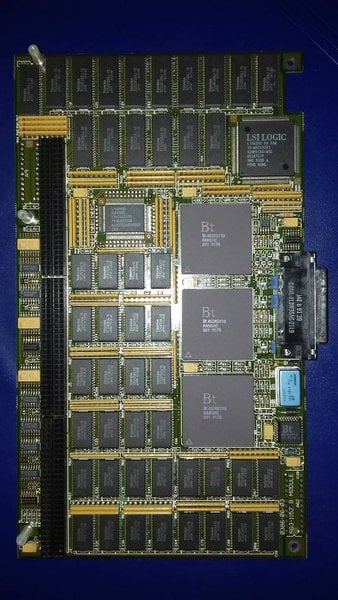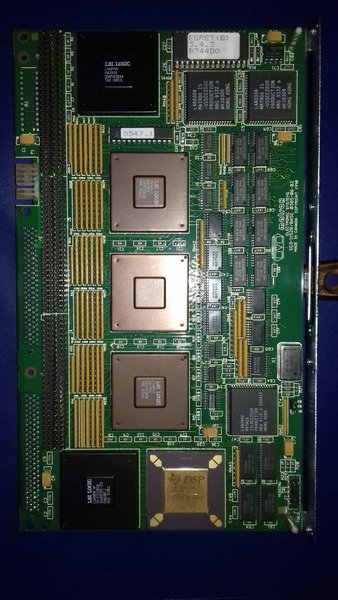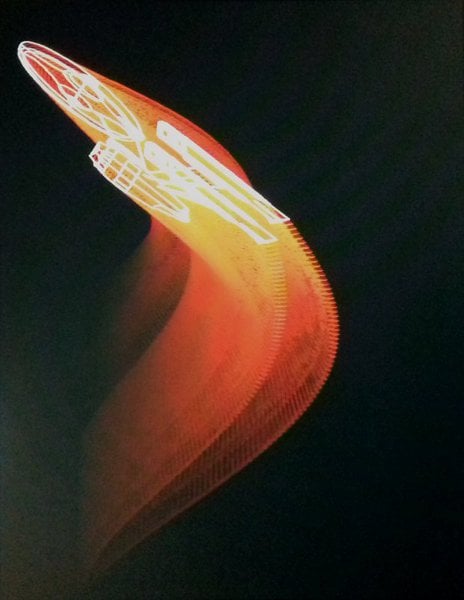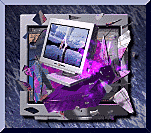Some pics of the GS CG12 (cgtwelve) 24-bit integrated accelerator and color frame buffer from 1990 for SBus-based SPARCstations (1/1+/2 and 5?), partitial manufactured by Matrox Electronic Systems, Canada. Used as affordable 3D desktop graphics solution. Placed between the CG6 (2D/3D wireframe, higher 2D perf) and GT (3D solids, higher 3D perf) graphics. Anounced with the SPARCstation 2GS, Nov 5 1990 (Src: The Florida SunFlash).
Installed in the SPARCstation 1+ (Sun-4/65) with plenty 16 MBytes of RAM.
Ultra short snap of the card running in OPB. Yes, black and white only with console. Not so under SunView and OpenWindows.
https://www.youtube.com/watch?v=buI5nwHcQw0
FIrst run with SunDIag 2.3.3 tests under SunOS 4.1.4 went all fine
(unfortunatelly only a photo of the screen)
A GFX tape comes with the GS for SunOS 4.1.1. GFX still needed for SunOS 4.1.4? I think the tape including SunPHIGS, SunGKS, SunVision and XGL developer libs (headers etc). - Unfortunatelly not in my supply.
Source: The Florida SunFlash, November 1990
Installed in the SPARCstation 1+ (Sun-4/65) with plenty 16 MBytes of RAM.
Ultra short snap of the card running in OPB. Yes, black and white only with console. Not so under SunView and OpenWindows.
https://www.youtube.com/watch?v=buI5nwHcQw0
FIrst run with SunDIag 2.3.3 tests under SunOS 4.1.4 went all fine
(unfortunatelly only a photo of the screen)
A GFX tape comes with the GS for SunOS 4.1.1. GFX still needed for SunOS 4.1.4? I think the tape including SunPHIGS, SunGKS, SunVision and XGL developer libs (headers etc). - Unfortunatelly not in my supply.

Code: Select all
Fully functional graphics:
- 24-bit true color
- 12-bit double buffer
- 16-bit Z-buffer
- 8 additional planes for overlays and windowing
- Gouraud shading with up to 8 lights
- Depth-cueing, hardware picking
- Multiple rendering modes
(...)
2. Graphics software:
* XGL runtime bundled on every system.
* SunPHIGS 1.3, SunGKS 3.0, SunVision 1.0, and XGL for developers
all orderable.
(...)
4.1.1 GFX:
(...) The GS also requires the installation of
the 4.1.1 GFX tape. This tape will be bundled in with the GS for both
the SPARCstation 2GS configuration and the upgrade. This means that the
customer does *not* need to order this tape as a separate line item.
(...) The GS will run without the 4.1.1 GFX tape, but will be
*SIGNIFICANTLY* slower and less reliable. Make sure this tape is
loaded. There are only a few files contained on this tape and
installation instructions are included. Installation should be under 30
minutes.
(...)
4. Third Party Graphics Applications
GS Applications:
* SDRC I-DEAS rev. 5 FY Q2 90
* MDC Unigraphics version 8
* PDA Patran
* MCS Anvil-5000
* MARC Analysis Mentat
* Prime/CV CADDS5X
* Prime/CV Medusa
* ICAD
* Fluid Dynamics FIDAP
* ERDAS
(...)
SPARCstation 2GS: Desktop 3-D Graphics
======================================
* 150K 3D vectors/sec (1) * Interactive 3-D performance
* 20K 3D Gouraud shaded polygons/sec (2)
------------------------------------------------------------------------------
Full-Featured Frame Buffers
- 24-bit true color * Displays 16.7 MM colors - realistic images
- 12-bit double buffering * Realistic graphics, smooth animation
- 16-bit Z-buffer * Dynamic hidden surface removal
- Overlay/enable planes * Three colors available to draw graphics over,
and independent of, 24-bit image data
- Window ID planes * Allow viewing of double-buffered
graphics in multiple windows with
high performance
------------------------------------------------------------------------------
Dynamic 3-D functionality in hardware
* Available through Sun PHIGS and Sun XGL
- Gouraud shading * Renders smooth, realistic 3-D models
- Eight colored light sources
* Adds visual realism
- Depth cueing * Visual aid for compex 3-D wireframe model
------------------------------------------------------------------------------
Advanced technology
- Compact packaging * Full-featured 3-D graphics integrated
into cost-effective SPARCstation 2 package
- Fast screen, Z-buffer clear
* Smooth animation
- Hardware picking * Allows quick, interactive selection and
highlighting of model elements
- Fast text, raster operations
* Highly responsive windowing environment
- Multiple rendering modes * 1-bit, 8-bit, and 24-bit applications can run
simultaneously
------------------------------------------------------------------------------
(1) 3-D vectors are 10 pixels long.
(2) 3-D polygons are 12-bit, double-buffered, 100 pixels triangles,
Gouraud-shaded, Z-buffered and clipped, through SunPHIGS.
(...)
System LP/USD Avail Configuration
---------------- ------- ----- -------------------------------------------------------
SPARCstation 2 $14,995 Now 16 MB, 19" monochrome (bwtwo), 207 MB disk
SPARCstation 2GX $17,995 Now 16 MB, 16" color accelerated graphics, 207 MB disk
SPARCstation 2GX $19,995 Now 16 MB, 19" color accelerated graphics, 207 MB disk
SPARCstation 2GS $26,995 Now 16 MB, 19" color, accelerated 3-D graphics, 207 MB disk
SPARCstation 2GT $49,995 120dy 16 MB, 21" color, accelerated 3-D graphics, 207 MB disk
SPARCstation 1 and 1+ GX to GS Upgrade
The GS upgrade includes the GS board, which requires 3 S-bus slots, a new 19" Sony
Trinitron 76Hz monitor, and connecting cables. Customers return their GX frame buffer,
color monitor, and cables.
The GS upgrade allows customers that are currently using software designed for GS level
performance to have a Sun solution for $9,995.
Sun
Solaris 2.4
@
SPARCstation 2
and
SNI
PCD-4H
. Migration path:
NetBSD


















 One day when I have enough guts and enough fun with it in its current 'shipped' configuration. The first SM-640 I've seen was manufactured mid-1987 (
One day when I have enough guts and enough fun with it in its current 'shipped' configuration. The first SM-640 I've seen was manufactured mid-1987 (


